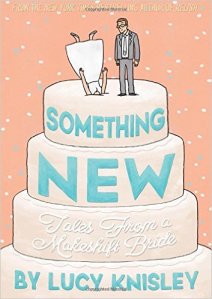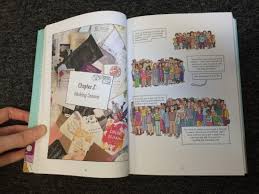 A health crisis recently overtook our family, with my son Daniel suddenly in the hospital a long way from our home. Now that his health is more stable, the problem being addressed, I find myself thinking about those questions and bits of wisdom that often seem distant from daily life. The whys and hows of existence. The truths underlying old clichés such as “Take time to smell the roses.” The reasons we have rituals to mark special occasions and milestone events. Aptly, I already had a copy of author/illustrator Lucy Knisley’s brand-new memoir about her own special occasion, Something New: Tales from a Makeshift Bride (2016), at home. The charms of this comforting, entertaining memoir led me to catch up with Knisley’s earlier, award-winning memoir, Relish: My Life in the Kitchen (2013). Her focused, lighthearted take there on two pleasurable daily activities sometimes overlooked in life’s bustle—eating and cooking—was just the tonic I needed. (Although, of course, a wedding of some sort may someday figure in my adult son’s future. No pressure there, son. All in your own good, long lifetime.)
A health crisis recently overtook our family, with my son Daniel suddenly in the hospital a long way from our home. Now that his health is more stable, the problem being addressed, I find myself thinking about those questions and bits of wisdom that often seem distant from daily life. The whys and hows of existence. The truths underlying old clichés such as “Take time to smell the roses.” The reasons we have rituals to mark special occasions and milestone events. Aptly, I already had a copy of author/illustrator Lucy Knisley’s brand-new memoir about her own special occasion, Something New: Tales from a Makeshift Bride (2016), at home. The charms of this comforting, entertaining memoir led me to catch up with Knisley’s earlier, award-winning memoir, Relish: My Life in the Kitchen (2013). Her focused, lighthearted take there on two pleasurable daily activities sometimes overlooked in life’s bustle—eating and cooking—was just the tonic I needed. (Although, of course, a wedding of some sort may someday figure in my adult son’s future. No pressure there, son. All in your own good, long lifetime.)
Lucy Knisley surprised her family and friends when, after three years apart, she and her former live-in boyfriend, John, became engaged. They had separated because Lucy wanted to have children but loveable John did not. Remaining friends who visited one another, sometimes vacationing together even as they dated other people, the late-20s couple finally got together when John changed his mind about kids. Something New  depicts these events plus the following year, when Knisley’s whole family (including her retired caterer mother) became involved in planning and hosting her large do-it-yourself (DIY) wedding. Her memoir is a satirical critique of the Western wedding industry, a humorous look at strange wedding traditions world-wide, and a wry, self-mocking expose of how Knisley’s obsessive involvement with fine, locavore cuisine and handicrafts took over her life during that wedding-planning year. Along the way, she continues the exploration, begun in Relish, of her close relationship with her free-spirit mother, with whom she lived after her parents’ divorce.
depicts these events plus the following year, when Knisley’s whole family (including her retired caterer mother) became involved in planning and hosting her large do-it-yourself (DIY) wedding. Her memoir is a satirical critique of the Western wedding industry, a humorous look at strange wedding traditions world-wide, and a wry, self-mocking expose of how Knisley’s obsessive involvement with fine, locavore cuisine and handicrafts took over her life during that wedding-planning year. Along the way, she continues the exploration, begun in Relish, of her close relationship with her free-spirit mother, with whom she lived after her parents’ divorce.
Sometimes Knisley’s cartoonish drawings illustrate the text, as in the circular panel showing John’s restless, midnight retrieval of an heirloom wedding ring from his family’s keepsakes box. At other points, drawings expand the text. For instance, after a visit with John that takes place during their separation, she writes in a narrative box that “John gave me a squeeze and sent me home to New York.” The panel, however,  shows sad-faced Lucy hugging her cat, with the word “GLOOM” in thin mauve letters dominating the rest of the panel. Throughout this work, the author/illustrator also cleverly uses photographs and photo-montages to both illustrate and comment on events. These include entire pages filled with cut-out magazine photos of brides and montages of actual wedding invitations Knisley had accumulated. I looked forward to these “real-life” pictures of the characters, places, and related items in this memoir—and you will too!
shows sad-faced Lucy hugging her cat, with the word “GLOOM” in thin mauve letters dominating the rest of the panel. Throughout this work, the author/illustrator also cleverly uses photographs and photo-montages to both illustrate and comment on events. These include entire pages filled with cut-out magazine photos of brides and montages of actual wedding invitations Knisley had accumulated. I looked forward to these “real-life” pictures of the characters, places, and related items in this memoir—and you will too!

Double spread pages devoted to such humorous topics as “Should I Go to This Wedding (A Flowchart)” and “”A Few Theme Weddings I Kinda Wish We Had Done” are also lively, clever elements here. Knisley deftly alters frame size or abandons frames altogether at apt moments, also effectively zooming in or out and altering perspective, throughout the memoir. An “Afterward from John,” written by the groom but drawn by the bride, and Knisley’s final “Thank you,” illustrated with their wedding photos conclude Something New in a gracious, satisfying way. Readers teen on up—and perhaps some a bit younger, if they have been involved in formal weddings—will appreciate this sharp-eyed, light-hearted treatment of one of life’s seriously joyful special occasions.
 Relish: My Life in the Kitchen (2013) follows Knisley from infancy, “a child raised by foodies” in New York City and later in upstate New York, through her college years. This memoir is infused with Knisley’s belief that her most “vivid memories jog [her] brain with the recollection of how things tasted.” These “taste-memories” are introduced early on, depicted as colorful, wordless balloons by the creative author/illustrator. Later, instead of the interspersed photographs found in Something New, Knisley interweaves sprightly cooking directions and recipes for some of her favorite foods and dishes. Readers will, for instance, learn how to best prepare mushrooms as well as how to cook huevos rancheros and sushi rolls.
Relish: My Life in the Kitchen (2013) follows Knisley from infancy, “a child raised by foodies” in New York City and later in upstate New York, through her college years. This memoir is infused with Knisley’s belief that her most “vivid memories jog [her] brain with the recollection of how things tasted.” These “taste-memories” are introduced early on, depicted as colorful, wordless balloons by the creative author/illustrator. Later, instead of the interspersed photographs found in Something New, Knisley interweaves sprightly cooking directions and recipes for some of her favorite foods and dishes. Readers will, for instance, learn how to best prepare mushrooms as well as how to cook huevos rancheros and sushi rolls.
Throughout, Knisley pays tribute to the spirit and skills of her caterer mother, who imparted her own delight with fresh foods and cooking to Lucy at home and at work. Readers tween and up will appreciate Lucy’s misadventures at a similar age helping out at farmers’ market stalls and, a few years later, working as a junior caterer alongside her mother. They will also enjoy her adventures with food and travel as a 14 year old visiting Japan and, as a college student, her encounter with Italian food and culture. Those aromatic, jam-filled croissants! Food is also a bond between Lucy and her gourmet father, even after her parents’ divorce when she is six. Great meals figure in mutual visits between her dad’s New York City apartment and upstate New York, with Lucy’s mother still preparing some of his most savored dishes.

Her “life in the kitchen” has shaped Knisley’s philosophy—beliefs set out near the Alex Award-winning book’s conclusion. There is much to mull over in adult Lucy’s realization that “eating is a social act. It’s a treat, even when the food is bad.” The memoir’s final panels contain other knowledge its creator wants to share. They show her at a stove, tasting a dish she is preparing. She smiles—perhaps at its taste but certainly as well at another important realization. She is doing “What I love. And doing those things with excitement, curiosity, and relish.”
 I am happy that my son already acts on similar beliefs. (A bit of a “foodie” himself, Daniel enjoys cooking, and last year we re-bonded over the pleasures of a new immersion blender.) I think Daniel’s appetite for life will sustain him as he faces medical adversity with the same empathy and gusto that have led him to travel the globe, tasting food and “tasting” cultures that most of us Westerners will never encounter. So many great meals, new places and people, and wonderful books ahead of him! Now added to my own pile of to-be-reads: Lucy Knisley’s autobiographical travelogues French Milk (2007), An Age of License (2014), and Displacement (2015).
I am happy that my son already acts on similar beliefs. (A bit of a “foodie” himself, Daniel enjoys cooking, and last year we re-bonded over the pleasures of a new immersion blender.) I think Daniel’s appetite for life will sustain him as he faces medical adversity with the same empathy and gusto that have led him to travel the globe, tasting food and “tasting” cultures that most of us Westerners will never encounter. So many great meals, new places and people, and wonderful books ahead of him! Now added to my own pile of to-be-reads: Lucy Knisley’s autobiographical travelogues French Milk (2007), An Age of License (2014), and Displacement (2015).
